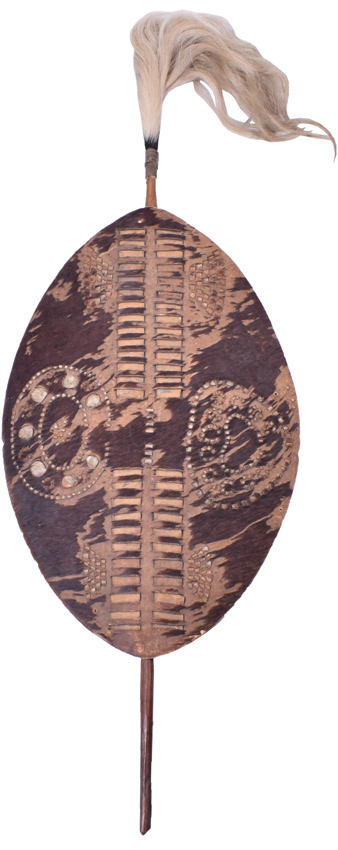Relics from the hard-fought defence of Rorke’s Drift in the Zulu War are among the lots for sale in a Kent auction as part of an extensive collection from the period.
Extracted from Antiques Trade Gazette | Tom Derbyshire
While the preceding Battle of Isandlwana ended up in one of Britain’s worst colonial defeats, Rorke’s Drift restored some pride with 11 Victoria Crosses awarded – and both 1879 battles are very popular collecting fields in the militaria market, with some crossover into tribal art.
The group to be sold in Tunbridge Wells by C&T Auctioneers was sourced by a private collector, Mick Woodfield. This month marks the 140th anniversary of these battles in the Zulu War.
Due to its size, the collection is being offered in two parts. Some 120 Zulu items are offered on January 9, then on April 24 the rest are featured along with other tribal lots Woodfield collected, such as South Sea items.
C&T militaria specialist Matthew Tredwen says: “I have never seen a Zulu collection as big as this in terms of quantity and the quality of items is fantastic. The collection has been amassed over the last 40 plus years and includes some very fine and rare items. Many of the items remain in very good condition.
“Although the client’s main interest was that of the Zulu people, he also has amassed other tribal items which will be offered in this auction.”
Tredwen launched C&T auction house with fellow dealer Glen Chapman in 2013.
“I’ve known Mick for quite a long time and when we first started the business he said if I ever sell my collection I’ll sell it through you,” said Tredwen. “Then out of the blue I saw him and he said ‘do you still want to sell my collection?’.”
Rorke’s Drift was made famous by the 1964 film Zulu starring Michael Caine and Stanley Baker, and it was that movie which first sparked Woodfield’s interest in the era as a child. He collected items from across the country and kept them in the attic of his Warwickshire home (some of the clubs he hadn’t actually looked at for around 20 years). Woodfield has now retired and has decided to sell the relics.
Battlefield finds
One of the lots comprises a framed display of battlefield relics recovered from Rorke’s Drift, including cartridge cases, bullet heads, brass buckle fitting, ration tin lid etc, professionally mounted in a glazed display frame along with seven coloured front-of-house film stills from the film Zulu.
According to C&T, these items “were all gifted to Mick Woodfield by fellow collectors who visited the battlefield at the time when there was still an abundance of relics to be found in the area and they could be removed, something that is no longer permitted”.
It is estimated at £600-1000.
A classic 1870s Isihlangu, an early example of the large war shield used by the Zulu warriors during the Anglo-Zulu wars, is guided at £1000-1500. The hide shield, 4ft 1in x 2ft 2in (1.24m x 66cm), is covered in white fur with light brown patches and spots.
Another familiar piece of Zulu arms and armour was the knobkerrie club. A 20in (50cm) high executioner’s example of this estimated at £300-500 features the large bulbous head completely covered in metal hobnails which, says C&T, “would have been collected from the boots of dead British soldiers on the battlefields of Zululand”.

The auction includes several examples of Zulu spears – the Assegais and Iklwa in particular. The former was thrown while the latter was the shorter stabbing weapon introduced during the military reforms of Shaka Zulu.
A high-ranking warrior’s/tribal leader’s Assegai described as a “superb example” with large leaf-shaped steel spear tip, 4ft 1in (1.25m) high overall, is estimated at £200-300.
Offered with the same guide is an 1870s Iklwa with some wear to the elongated steel leaf shaped blade “due to combat use”. The blade measures 16in (40.5cm) and the weapon overall is 3ft 5in (1.05cm) long.
Carried to Britain

While some of the relics come with a basic provenance, as bought by Woodfield, one in particular has a very interesting background.
A Zulu shield and weapons grouping estimated at £800-1200 was brought back to the UK from Durban, Natal, in 1886 by a Mr Mayers on the steamship Clan Lamont. It was collected possibly from the battlefields.
Accompanying the items is the original 1st class passenger ticket for the steamer which Mayers travelled on, dating from April 22, 1886. There is a note to the reverse of the ticket but C&T has been unable to decipher this due to the state of the handwriting.
Ceremonial shield

Asked to pick a personal favourite from the collection, Tredwen plumped for a Zulu chief’s ceremonial shield, described as a “very unusual early example of the small type hide shied which has been beautifully decorated by hand with geometric patterns in leather work”.
The catalogue adds: “Due to the fine detail which has gone into constructing this shield it must have been made for someone of importance to the tribe.”
The estimate is £400-600.

